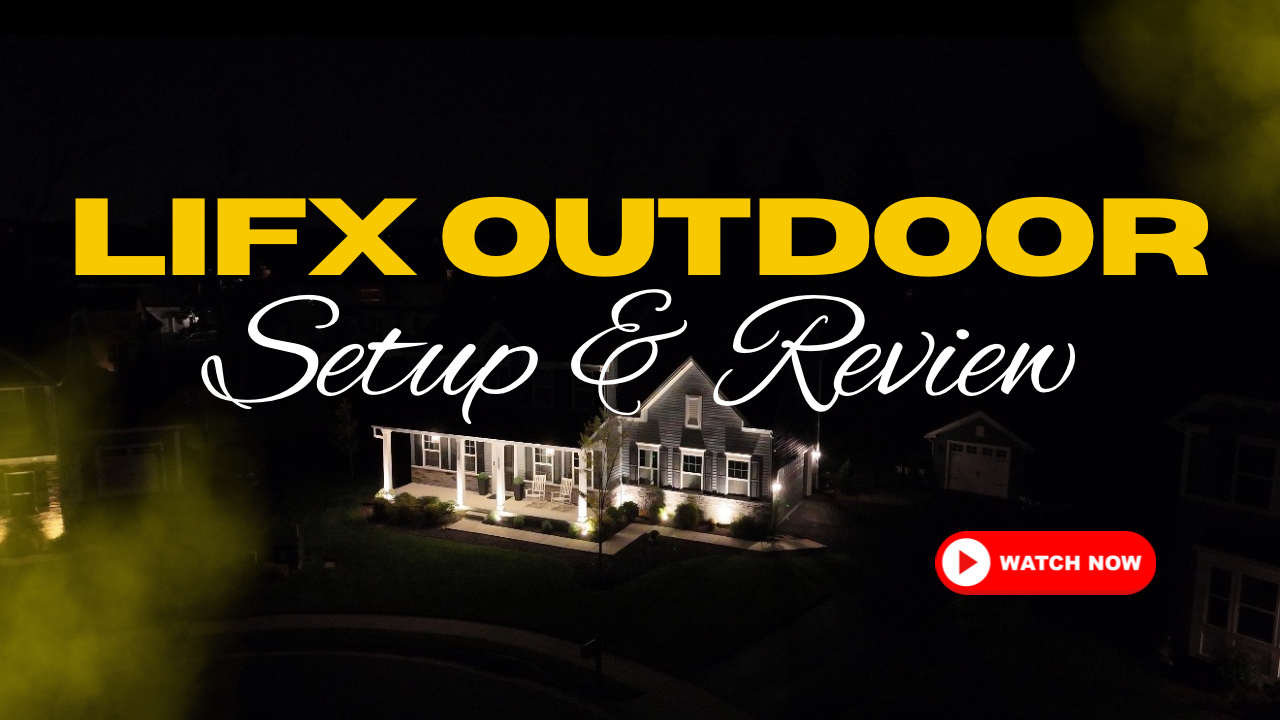Looking for smart landscape lighting without adding another hub? Here’s my honest experience installing and living with LIFX outdoor spot LED landscape lights over the past six months.
Prefer to watch instead of read?
Why LIFX Over Philips Hue?
When researching smart landscape lighting options, I quickly realized there weren’t many comprehensive reviews of the LIFX outdoor spot LED landscape lights. These relatively new products seemed promising but lacked the coverage that Philips Hue alternatives typically receive.
My decision to go with LIFX instead of Philips Hue came down to one main factor: no additional hub required. I already have plenty of smart home hubs (Lutron Caseta, Apple TV for HomeKit, etc.), and adding another device to my setup felt unnecessary. With LIFX, I can connect each light directly to my Wi-Fi network. While some might question adding eight devices versus one hub, this approach has worked well for my setup. Plus, these lights support Matter, which is a nice bonus for future compatibility.
Unboxing and First Impressions
Each LIFX outdoor light comes individually packaged with:
- The light fixture with a generously long cord
- A voltage converter
- A quick connector for landscape light wiring
- Multiple mounting options including:
- A metal ground spike
- A surface mounting plate
- An extension rod (adds about 3 inches of height)
- Mounting screws
The lights themselves are quite substantial in size, featuring multiple LED diodes that promise bright illumination. One initial concern was that each light has a unique Matter QR code, which isn’t immediately visible on the light itself but is actually printed on the bottom of each fixture. I still recommend labeling each light (I used acrylic markers) to make future identification easier.
What You’ll Need for Installation
Beyond the lights themselves, you’ll need:
- Low voltage landscape wire (I used 250 ft of 12/2)
- A transformer (I used a 12V/14V Wi-Fi enabled transformer)
- Basic tools (shovel for burying wires, wire cutters, etc.)
Installation Process
Step 1: Planning Your Layout
I planned to use my eight lights for:
- Four lights across the front of the house to illuminate the columns
- Three lights along the side of the garage
- One light to accent a tree in the front yard
Before digging or running any wires, I placed all the ground spikes approximately 12 inches from the walls to achieve a nice wall-washing effect.
Step 2: Installing the Ground Spikes
The metal ground spikes are sturdy and easy to install. In most cases, I could push them into the ground by hand, despite our dry Pennsylvania soil. The manufacturer mentions you can use a mallet if needed, but I didn’t find this necessary.
For the tree accent light, I removed the extension rod to position it lower for better illumination.
Step 3: Wiring the Lights
Connecting the lights is straightforward:
- The cord from the light plugs into the voltage converter provided by LIFX
- The landscape wire connects to the voltage converter using the included connector
- When running landscape wire, note that one side has white text (common line) and the other is plain black
- The white wire from the LIFX connector connects to the wire with text, and the black wire connects to the plain wire
- The connector has a ratcheting mechanism that punctures the wire insulation when squeezed together
Step 4: Installing the Transformer
I mounted the transformer on an exterior wall near an outlet. While hardwiring would be ideal, the plug-in approach works fine for my needs. From the transformer, I ran three main lines to a junction box, which then distributes power to all eight lights.
Step 5: Setup in the App
Adding the lights to the LIFX app is generally straightforward, though I did encounter some firmware update issues with one light that required a reset and manual connection.
Long-Term Performance: The 6-Month Verdict
After living with these lights for approximately six months, here are my honest thoughts:
The Good
- Excellent illumination with a nice color palette
- Direct Wi-Fi connection eliminates the need for a hub
- Seamless integration with my existing smart home setup
- Quality appearance that enhances my home’s exterior
The Not-So-Good
- Connectivity issues occasionally occur (typical of LIFX products)
- Price point is quite high compared to non-smart alternatives
- One power inverter failed within the first six months (though LIFX support promptly sent a replacement at no cost)
My Solution to Connectivity Issues
To mitigate the Wi-Fi connectivity problems, I connected the lights to a Wi-Fi-enabled transformer that automatically turns on at sunset and off at sunrise. This approach forces the lights to establish a fresh connection each evening, which has significantly improved reliability.
Are They Worth It?
The question of value depends on your priorities. If you’re deep into smart home technology and want landscape lighting that integrates with your existing ecosystem without adding another hub, these are worth considering. The color options, brightness, and overall quality are excellent.
However, if you’re looking for the most cost-effective landscape lighting solution and don’t care about smart features, there are certainly cheaper options available.
Final Thoughts
The LIFX outdoor spot LED landscape lights have been a welcome addition to my smart home setup. Despite some minor connectivity issues and one hardware failure (which was promptly addressed by customer service), I’m generally pleased with their performance and appearance.
Would I recommend them? Yes, but with the caveat that you should be prepared for occasional connectivity hiccups and a significant investment compared to traditional landscape lighting.
Have you installed smart landscape lighting? Which system did you choose? Let me know in the comments below!

Leave a Reply